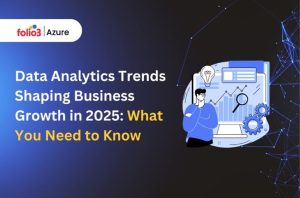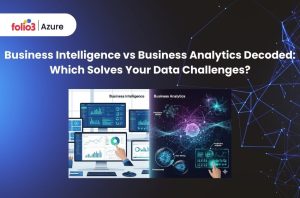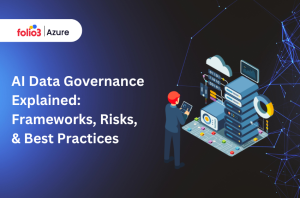Table of Contents
ToggleWhat is the Role of AI in Predictive Analytics?
AI’s role in finance moves analytics from static to dynamic. Instead of once-a-quarter projections, AI systems update forecasts in real time as new data flows in.
Dynamic forecasting: Traditional forecasts, based on stale assumptions, quickly become obsolete. In contrast, AI models continuously retrain on fresh sales, payment, and economic data, keeping projections up-to-date.
Real-time risk management: AI also flags subtle anomalies across vast data, from unusual payment delays to supply chain disruptions, enabling proactive mitigation. For instance, AI can spot a late-paying customer or a sudden cost spike in supplier deliveries as a warning signal, long before manual review.

Insight-Driven Collaboration
AI breaks down silos by delivering unified, real-time insights across departments. CFOs can share interactive dashboards showing how sales trends affect cash flow or how market shifts impact budgets. Every team – from HR to sales- accesses the same data “playbook,” aligning strategies and reducing lag time in decision-making.
Discovering Data-Backed Advantages
Predictive AI doesn’t just cut risk, it finds value. Machine learning can spot non-obvious patterns (for example, a niche customer segment with high profitability) that humans might overlook.
By analyzing hundreds of variables and historical outcomes, AI reveals patterns and opportunities often hidden in plain sight. As a result, it helps financial leaders seize new revenue or efficiency gains.
Faster, Smarter Decisions
Perhaps most critically, AI accelerates the finance cycle. Tasks that once took weeks, data aggregation, variance analysis, and report generation, are now automated. CFOs gain actionable foresight instead of lagging hindsight.
In practice, this lets finance pivot quickly: instead of waiting months for a forecast update, leaders see the latest numbers in days or hours, turning strategy into execution faster.
By reshaping forecasting and analysis this way, AI forges a predictive, data-driven finance function. The change is stark: whereas finance teams used to labour over historical data to produce forecasts often obsolete by the time they are shared, AI now keeps forecasts alive and relevant.
In short, the role of AI in predictive analytics is to make finance more agile, connected, and insightful. It brings a transformation that CFOs are already feeling in stronger cash positions and more resilient plans.
What are the Key Capabilities of AI Predictive Analytics?

It may include economic indicators, market rates, customer behaviors, social media signals, etc., to predict outcomes. In practice, this means tighter inventory management, more precise budgeting, and smarter debt planning.
Other capabilities include:
Anomaly Detection and Early Warning
Machine learning systems scan transactions and KPIs to flag deviations. If a customer suddenly slows payments or a cost center spikes spend, AI alerts finance leaders early.
A report found that banks using AI saw default rates drop by 20% and operating costs fall by 15% in one year, illustrating how timely AI warnings can pre-empt losses.
Scenario Simulation (“What-If” Analytics)
Advanced analytics platforms let CFOs model hypothetical changes. For instance, AI can simulate how changing payment terms or loan interest rates would affect cash flow.
Furthermore, finance teams can simulate various adjustments to payment terms and assess their potential impact on cash reserves, empowering strategic planning.
Loan and Repayment Prediction Models
Banks and lenders use AI to forecast loan repayment likelihood and optimize credit terms. By learning from historical repayment patterns, macroeconomic data, and even social/behavioral signals, predictive models can assign dynamic risk scores to borrowers.
AI-driven credit scoring can reveal early default risks, prompting adjustments to loan terms. Therefore, leading banks now assess credit risk more accurately and identify potential defaults early on through predictive analytics.
Interest Rate Prediction Technology
Beyond loans, AI also forecasts market interest rates. Recent research shows deep learning models can reliably predict money-market rates up to a year ahead. This “interest rate prediction technology” can help treasurers optimize debt issuance and refinancing.
As one study notes, deploying these AI models could enable companies to “optimize debt issuance strategies by reducing borrowing costs”. In practice, this means better timing of bond issuance or loan draws, directly cutting financing expenses.
How is AI Powering Cash Flow and Credit Management?
One of the most tangible impacts of predictive AI in finance is on cash flow management and credit usage critical for every CFO. An AI cash flow model analyzes historical receipts, payment lags, and seasonal trends to forecast liquidity with high fidelity.
For example, AI can detect that Customer A always pays on the 30th of each month, while Customer B slows payments in Q4. These insights let treasury teams schedule collections and supplier payments more strategically.
Practically, this means companies rely less on expensive short-term borrowing. By knowing exactly when money arrives or is needed, businesses “avoid unnecessary credit usage, which reduces interest expenses and enhances financial stability”.
This AI-driven interest cost reduction can be significant: fewer surprise shortfalls mean fewer high-interest draws on credit lines. KPMG’s research confirms many finance leaders have already seen these benefits; among AI “leaders,” 57% report ROI exceeding expectations, often due to lower financing costs.
Key ways AI boosts cash and credit management include:
Accurate Payment Behavior Analysis
AI processes client payment histories to uncover hidden patterns. For instance, it may be learned that one distributor pays 45 days late in winter while another pays weekly without exception. These granular profiles feed forecasts, so your model knows exactly when each receivable will clear.
Precise Cash Forecasting
With AI insights integrated, forecasts become more realistic. Finance teams can then “time supplier payments without incurring penalties” and schedule debt service to minimize interest.
For example, if a model predicts a cash shortfall in mid-February, a CFO could pre-arrange a slightly larger credit line in January rather than scrambling for funds at peak interest in March.
Strategic Credit-line Management
Armed with clarity, companies can judiciously use credit. They avoid unnecessary draws, negotiate better terms (showing lenders data-driven confidence), and preserve credit ratings.
Moreover, AI helps to negotiate better credit terms with lenders by demonstrating a data-backed approach to liquidity management.
Scenario Planning
AI tools let finance leaders simulate various adjustments like extending payables or adjusting collection incentives.
This accelerates proactive decision-making under different market conditions. For instance, a company could test the impact of offering a 2% early-pay discount to key customers, directly quantifying the cash boost versus margin cost.
Stronger Supplier and Lender Relationships
By predicting and planning cash needs, companies pay vendors and lenders on time, even early if possible. This reliability builds trust, which can secure longer payment terms or lower interest.
A stable cash flow builds trust and secures better terms with suppliers, while borrowers who demonstrate smart cash management often receive reduced lending rates.
How AI Helps with Credit Risk and Lending?
Financial leaders are rethinking how they assess borrower risk, price loans, and manage credit exposure.
Traditional models often miss key signals, but AI brings a broader, deeper understanding of risk in real time. This section explores how predictive analytics enables faster, smarter lending decisions while reducing defaults and optimizing interest rates.
Holistic Risk Profiling with AI
Just as AI sharpens cash forecasts, it revolutionizes credit risk management and lending decisions. Traditional credit models rely on limited historical data. AI, however, ingests vast and varied inputs from transaction histories and economic indicators to non-traditional data like social behavior or business reviews.
The result: much more holistic risk scores. For example, banks like JPMorgan and Wells Fargo now use AI to scan wide-ranging borrower data in real time, enabling early detection of potential defaults.
Predictive AI lets these banks assess credit risk more accurately and identify potential defaults early on. When such anomalies pop up, finance teams can intervene: tightening credit limits or refinancing loans proactively.
Dynamic Loan Pricing and Interest Rate Optimization
The benefits are measurable. AI-driven credit assessment has cut default rates by up to 20% in some cases. This happens because AI not only flags trouble early but also optimizes lending terms.
For example, if a model spots that a particular segment is now lower-risk, a CFO could offer them a lower interest rate as an incentive, improving customer retention.
Conversely, riskier profiles might be offered shorter terms or higher rates automatically. Moreover, AI can personalize credit offers, recommending appropriate credit limits, interest rates, and repayment terms based on real-time risk profiles.
Faster Underwriting and Operational Efficiency
Moreover, AI accelerates underwriting: JPMorgan famously cut hours of document review down to minutes by AI, allowing faster loan approvals.
Customers get quicker decisions, and banks save on processing costs. With less manual intervention, operational expenses fall.
Studies show banks adopting AI have seen their operating costs in credit functions drop significantly. All told, AI in credit risk assessment means less loan loss, faster service, and more precise loan pricing – a powerful combination for financial stability.
Implementation & ROI: Making AI Work for Finance
Investing in AI isn’t just about adopting a trendy tool; it’s about measurable impact. This section guides decision-makers on how to prioritize high-ROI use cases, avoid common pitfalls, and strategically deploy AI across finance operations. Learn how to turn AI from a cost center into a true performance multiplier.
Prioritizing High-Impact Use Cases
For finance leaders, the question isn’t if to adopt AI-driven analytics, but how. Industry research underscores that focusing on the right use cases yields the biggest returns.
A BCG survey finds that high-ROI finance teams prioritize impactful applications, notably in risk management and forecasting. In practice, this means deploying AI where it touches the bottom line: improving forecast accuracy, optimizing working capital, and preventing costly credit events.
Real Financial Gains from AI Investment
Statistics back this up. While many CFOs now invest in AI, the median ROI is modest (around 10%) when AI is applied haphazardly. However, targeted projects pay off. For example, predictive analytics in treasury might reduce borrowing costs by 10–15%, and credit analytics might cut bad debts by a similar margin.
One analysis reports that every $1 invested in AI yields about $3.50 in value. Likewise, McKinsey notes that AI-enhanced forecasting alone can improve accuracy by ~10% and lower costs by ~15%. These figures highlight that AI is not just a cost center – with smart implementation, it becomes a high-return investment.
Smart Adoption Strategies for Finance Teams
To achieve that return, decision-makers should treat AI like any other strategic initiative. Build cross-functional teams combining finance expertise and data science.
Start with clean, relevant data and clear objectives. Use low-code AI platforms if data science talent is scarce, as these tools can let financial analysts build predictive models without deep coding, greatly shrinking development time. Monitor results tightly: track not only technical metrics (like forecast error) but also business outcomes (interest saved, working capital released).
Long-Term Optimization Through Learning Models
Finally, think long-term. AI thrives on learning. The more you feed these models with real outcomes (did the predicted late payment actually happen?), the smarter they get.
Over time, predictive models for cash flow, revenue, or risk will grow increasingly accurate, continuously optimizing your finance function. Many companies even embed AI agents to automate routine tasks (invoice matching, anomaly alerts, etc.), freeing finance staff for strategic analysis.
Conclusion
In summary, AI is revolutionizing predictive analytics in finance by turning data into foresight. Financial leaders now have tools that not only forecast but also prescribe: identifying interest cost savings, optimizing lines of credit, and highlighting hidden opportunities in the numbers.
By leveraging AI for cash flow modeling, credit analysis, and scenario planning, companies can reduce borrowing costs, bolster liquidity, and make more confident, data-driven decisions. The benefits are already real – from CFOs who have doubled their forecast accuracy to treasurers who are cutting emergency borrowing in half.





